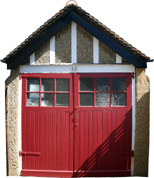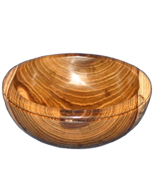Current Woodturning Project.
A Gift of English Walnut Juglans regia.
English Walnut (Juglans regia), harvested from a
tree felled near Bovingdon, Hertfordshire, UK.
These two trunk slices and four branch pieces came from
a large Walnut tree (trunk diameter 700mm,
27½"), felled in March-April 2016 at a farm near
Bovingdon in Hertfordshire, UK. The tree had to be
felled because the base of the trunk had rotted, and
the tree was in danger of toppling over.
We were offered the wood by friends living at the farm,
when they became aware that I was looking out for
turning wood. After felling, the timber had been stored
in the open air where the eventual aim was to cut it up
for firewood!
I harvested the wood on the 9th July 2016,
some 3 - 4 months after felling, and was disappointed
to see that the trunk had been sliced across at
intervals of about 150mm - 180 mm (6" - 7"), so there
were no long trunk lengths. I was pessimistic and
expected the wood to show excessive splitting,
especially after 3 to 4 months of outdoor spring and summer
weathering.
The wood showed surface staining and it was impossible
to see any fresh unweathered surfaces and evaluate
quality.
The samples shown above were therefore harvested more
in hope than in expectation.
Preparation & Rough Turning.
![[Bovingdon Walnut - click for full size picture] Bovingdon Walnut.](images/line-of-cut-01thmb.jpg)
|
Trunk Slice 1.
The top photograph shows the line (in red), of the
first cut across the trunk slice.
The lower photograph shows one half of the trunk
after cutting along the line with an electric
chainsaw. To my surprise both the heartwood and
sapwood were in good condition with beautiful
figuring, minimal weathering and no splitting (as
might have been expected), in the vicinity of the
pith. 9th July 2016.
(Click on images for larger views)
|
![[Bovingdon Walnut - click for full size picture] Bovingdon Walnut.](images/img_2600crthmb.jpg)
|
![[Bovingdon Walnut - click for larger view] Bovingdon Walnut.](images/img_2603crthmb.jpg)
|
End-grain bowl.
It was decided to try and make an end-grain bowl
from half of the slice. This photograph shows the
bowl marked out, ready for cutting on the bandsaw.
9th July 2016.
(Click picture for larger view)
|
![[Bovingdon Walnut - click for larger view] Bovingdon Walnut.](images/img_2607crthmb.jpg)
|
Making the Bowl Blank.
Cutting out a circular bowl blank on the bandsaw.
9th July 2016.
(Click picture for larger view)
|
![[Bovingdon Walnut - click for larger view] Bovingdon Walnut.](images/img_2881cradthmb.jpg)
|
Ready to Turn.
Mounted securely on the lathe, ready to rough turn.
26th July 2016.
(Click picture for larger view)
|
![[Bovingdon Walnut - click for larger view] Bovingdon Walnut.](images/img_2886crthmb.jpg)
|
Outside Rough Turned.
The exterior of the bowl after rough turning. Note
the spigot which will be gripped by the jaws of the
lathe chuck when the bowl is reversed for hollowing
out. Bowl diameter 263mm (10⅜").
26th July 2016.
(Click picture for larger view)
|
![[Bovingdon Walnut - click for larger view] Bovingdon Walnut.](images/img_2890crthmb.jpg)
|
Bowl Reversed for Hollowing.
The bowl reversed on the lathe and showing the
original 60mm diameter hole, drilled into the blank
with a Forstner bit, and used to initially attach
the bowl to the lathe by expanding the jaws of the
chuck within the hole.
Normally the inside of the bowl would be hollowed
out using a bowl gouge. Because the wood was so
spectacular, it was decided to use a Woodcut
Bowlsaver to cut out two smaller bowls from
wood which would otherwise be gouged out and
discarded as waste. 26th July 2016.
(Click picture for larger view)
|
![[Bovingdon Walnut - click for larger view] Bovingdon Walnut.](images/img_2900crthmb.jpg)
|
First "Daughter Bowl" Core.
The Bowlsaver has been successfully used to
cut the first "Daughter Bowl" from the "Mother
Bowl". 26th July 2016.
(Click picture for larger view)
|
![[Bovingdon Walnut - click for larger view] Bovingdon Walnut.](images/img_2907crthmb.jpg)
|
Rough Turning the First "Daughter Bowl" Core.
The exterior of the 1st daughter bowl has been
roughly shaped. A spigot has been cut to facilitate
the reversal of the bowl for hollowing out. Bowl
diameter 182mm (7¼"). 26th July
2016.
(Click picture for larger view)
|
![[Bovingdon Walnut - click for larger view] Bovingdon Walnut.](images/img_2908crthmb.jpg)
|
1st "Daughter Bowl" reversed for Hollowing.
The bowl reversed on the lathe ready for hollowing.
As for the first bowl, because the wood was so
spectacular, it was decided to use the
Bowlsaver to cut out another "2nd Daughter
bowl" from the 1st "Daughter Bowl". 26th
July 2016.
(Click picture for larger view)
|
![[Bovingdon Walnut - click for larger view] Bovingdon Walnut.](images/img_2912rotcrthmb.jpg)
|
2nd "Daughter Bowl" Created.
The Bowlsaver has been successfully used to
cut the 2nd "Daughter Bowl" from the "1st Daughter
Bowl". 27th July 2016.
(Click picture for larger view)
|
![[Bovingdon Walnut - click for larger view] Bovingdon Walnut.](images/img_2917crthmb.jpg)
|
Rough Turning the 2nd "Daughter Bowl" Core.
The exterior of the 2nd daughter bowl has been
roughly shaped. A spigot has been cut to facilitate
the reversal of the bowl for hollowing out. Bowl
diameter 103mm (4⅛"). 27th July
2016.
(Click picture for larger view)
|
![[Bovingdon Walnut - click for larger view] Bovingdon Walnut.](images/img_2922rotcrthmb.jpg)
|
2nd "Daughter Bowl" reversed for Hollowing.
Ready for conventional hollowing with a bowl gouge.
Bowl diameter 103mm (4⅛"). 27th
July 2016.
(Click picture for larger view)
|
![[Bovingdon Walnut - click for larger view] Bovingdon Walnut.](images/img_2926crthmb.jpg)
|
2nd "Daughter Bowl" Hollowed.
Hollowing with a bowl gouge completed.
27th July 2016.
(Click picture for larger view)
|
![[Bovingdon Walnut - click for full size picture] Bovingdon Walnut.](images/img_2927crthmb.jpg)
|
The Three Rough-turned Bowls
Photographs of the three rough-turned bowls made
from one bowl blank that was turned to make the
first "Mother Bowl" and which was then cored twice
to make the two "Daughter Bowls". 27th
July 2016.
(Click on images for larger views)
|
![[Bovingdon Walnut - click for full size picture] Bovingdon Walnut.](images/img_2935crthmb.jpg)
|
![[Bovingdon Walnut - click for full size picture] Bovingdon Walnut.](images/img_2937crthmb.jpg)
|
Drying the Bowls.
Turning end-grain bowls from green wood which includes
the pith, is risky as there is a very high likelihood of
the wood splitting, with the splits emanating from the
high stress area in the vicinity of the pith. To try and
minimise the risk, the bowls have been air dried very
slowly in the workshop and monitored for water loss by
weekly weighing. Drying has now been completed and much
to my surprise, to date (12th January 2017),
there has been no splitting and very little warping, in
spite of a water loss in excess of just under 40%. A
table with graph of the weighing data is shown below.
An Open Office table (embedded in a text
document), was used to record the data. Just the
date and the weight (in grams) were entered
into the table which was set to automatically calculate
relevant analytical data in the adjacent columns.
Computed data categories were Elapsed days (since
the first weighing), the Cumulative loss (grams)
(since the first weighing), % loss (in weight
compared to the first reading), and Amount lost
(in grams) from the previous weighing.
There is an optional column for any relevant comments.
An Open Office spreadsheet was used to plot a
graph of time against weight which gives a useful
overview of the drying progress.
Note that for presentation here, the Open Office
graph has been converted to a JavaScript chart created
with AM Charts
![[Bowl drying data - click for full size picture] Bowl drying data.](images/doc-2016-07-09-01bthmb.jpg)
|
Drying Data for the "Mother Bowl" (Completed).
The top picture links to a table showing the
recorded weights of the bowl taken on the day it
was rough turned and on a weekly basis thereafter.
This is a good way of monitoring the seasoning (or
drying) progress of the bowl. When there is no
change in the weekly readings of weight, then the
wood has effectively dried out (is in equilibrium
with the temperature and humidity of the storage
area), and the bowl is ready for final turning and
finishing. On the 1st January 2017,
after 154 days, the bowl had lost 956
grams in weight of which 0 grams had
been lost since the bowl was last weighed 7 days
previously. The bowl was judged to have reached
equilibrium moisture content.
Drying Graph for the "Mother Bowl"
(Completed).
The lower picture links to a graph plotted from the
drying data (top picture). The curve of this graph
gives a useful overview of the drying process. On
the 1st January 2017, the curve of the
graph indicated that the bowl was fully seasoned
with slight fluctuations in the weight of the bowl,
reflecting changing values of the RH in the
workshop. The bowl has effectively attained its
EMC. The next step will be to re-mount it on
the lathe for final shaping and sanding to
completion.
(Click pictures for larger views)
|
![[Drying Graph - click for larger view] Drying Graph.](graphs/graph-2016-07-09-01bthmb.jpg)
|
The bowl is ready for final turning and completion, the
description of which will be added here in due course
(13th January 2017).
What Happened to the rest of the Harvested Wood?
The rest of the wood was equally as good and prepared as
outlined below.
![[Bovingdon Walnut - click for full size picture] Bovingdon Walnut.](images/img_2697crthmb.jpg)
|
Trunk Slice 2.
The Walnut trunk slice has been marked out to make
another much larger end-grain bowl some 432mm (17")
in diameter. 10th July 2016.
(Click on image for larger view)
|
![[Bovingdon Walnut - click for full size picture] Bovingdon Walnut.](images/img_2728crthmb.jpg)
|
Ready to Turn.
The end-grain Walnut bowl bowl blank mounted on the
lathe, ready to turn. 13th July 2016.
(Click on image for larger view)
|
![[Bovingdon Walnut - click for full size picture] Bovingdon Walnut.](images/img_2732crthmb.jpg)
|
Work in Progress 1.
The Walnut blank has been turned to a cylinder and
the wood is looking good. Note that a 6" faceplate
is essential to attach an end grain blank of this
size securely to the lathe. 14th July
2016.
(Click on image for larger view)
|
![[Bovingdon Walnut - click for full size picture] Bovingdon Walnut.](images/img_2736crthmb.jpg)
|
Work in Progress 2.
The exterior of the Walnut bowl has been rough
turned and a spigot cut for reversal and coring
with a Bowlsaver. 14th July 2016.
(Click on image for larger view)
|
![[Bovingdon Walnut - click for full size picture] Bovingdon Walnut.](images/img_2812rotcrthmb.jpg)
|
Work in Progress 3.
The three rough-turned Walnut bowls produced after
coring the original bowl blank with a
Bowlsaver. 14th July 2016.
(Click on image for larger view)
|
![[Bovingdon Walnut - click for full size picture] Bovingdon Walnut.](images/img_2816crthmb.jpg)
|
Work in Progress 3.
Another picture of the three rough-turned Walnut
bowls produced after coring the original bowl blank
with a Bowlsaver. 14th July 2016.
(Click on image for larger view)
|
![[Bovingdon Walnut - click for full size picture] Bovingdon Walnut.](images/img_2824crthmb.jpg)
|
Branch-wood
The harvested branch-wood of the Walnut was equally
spectacular as shown in this photograph of a crotch
sliced in half with the chainsaw. 23rd
July 2016.
(Click on image for larger view)
|
![[Bovingdon Walnut - click for full size picture] Bovingdon Walnut.](images/img_2686crthmb.jpg)
|
Prepared Walnut Blanks - 1
Blanks prepared by chainsaw and then bandsaw.
9th July 2016.
(Click on image for larger view)
|
![[Bovingdon Walnut - click for full size picture] Bovingdon Walnut.](images/img_2838-compositethmb.jpg)
|
Prepared Walnut Blanks - 2
Blanks prepared by chainsaw and then bandsaw for
spindle turning. 9th July 2016.
(Click on image for larger view)
|
Project started July 2016, on-going
Click HERE to return to the Home Page.
© Tim & Trish Enterprises 2015-2017.


![[Photograph of English Walnut harvested from a tree felled near Bovingdon, Hertfordshire, UK] Photograph of English Walnut harvested from a tree felled near Bovingdon, Hertfordshire, UK.](images/img_2598adjusted.jpg)